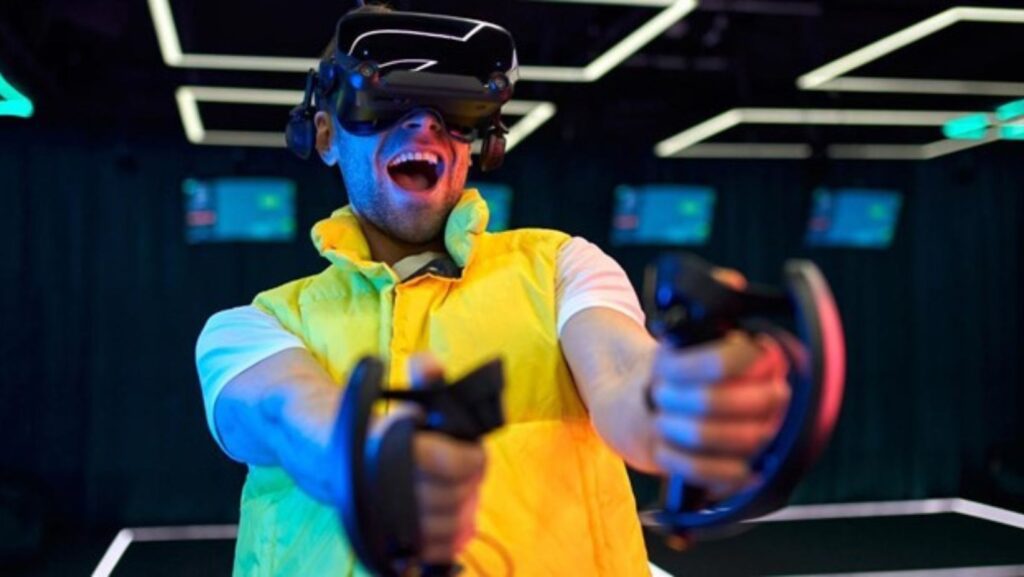Remember those days of pixelated adventures—dodging pokeys as Mario or building epic empires in Civilization? Gaming was the escape and playground for many young gamers. Fast-forward to today, when VR has entered the gaming industry. And boom, a lot changed!
The VR-based games are here to take you inside the world of your favorite game. The combination of virtual and physical reality is like living inside video games.
Let’s check out some key features and functionalities of VR-powered games.
Table of Contents
ToggleBuilding Immersive Environments
Immersive environments are the core of VR game designs. Today, game developers and designers can interact more naturally in a virtual environment using VR hardware. That said, they have more resources to amplify the appeal of game designs.
Spatialized audio and 3D-rendered visuals make objects within the game environment more interactive. Kick a rock, open a door, mess around – it all feels natural to players. The high level of detailing makes you feel like you’re actually there.
VR game players see the action directly from their character’s eyes. Hence, the experience gaming enthusiasts get with VR technology is worth it.
Your New Playtime Arsenal: Game On
Forget the old-school controllers! VR has upped the game (literally, yeah). From simple goggles to high-tech helmets that track your every move, there’s a headset for every kind of game. You can grab, throw, and point as you’d in real life.
There are also VR gloves that let you interact with the game world like never before. Feel the virtual world with haptic feedback – like stepping into another reality.

And if that’s not enough, you have steering wheels for racing, joysticks for flying, and even tennis paddle grips. It’s like bringing the arcade home.
Of course, none of this would be possible without the VR headset. It’s your portal to incredible virtual worlds. So, get ready for a whole new level of immersion with access to cutting-edge VR gear.
Social VR: Meet Your Metaverse Buddy
VR technology goes beyond the gaming industry. Today, there’s a social VR that’s bringing people together in ways we never thought possible.
Consider social VR a blend of chat rooms and real-life gatherings. It’s all about having fun and meeting new people from across the globe without leaving your couch. Whether you’re a chatty extrovert or a quiet introvert, there’s a place for everyone in this new-age VR world.
So how does it work?
First, pick your avatar. Do you want to be a cat, a robot, or even a giant pizza? The choice is yours! Once you’ve nailed your look, create your own chill spot or join a public room to meet and greet new, like-minded people. The world of social VR parties is vast, from dance parties to virtual yoga.
Current VR Trends in Gaming and Entertainment Segment
Today, programmers create VR-based games in various genres to make the gameplay more engaging. VR elements in these games replicate real-life scenarios in a virtual environment, such as sports, stimulation, narrative, and action-adventure games.
A realistic and interactive environment takes a gamer’s playtime to the next level.
Another emerging trend is the advent of VR gaming in the online gambling market. VR-powered casinos imitate the sensations of a physical casino, with gestural controls and real-like environments. So, you’ll feel like playing on the traditional casino floor when you wager on the Ducky Luck Casino legit site. Players can even interact with fellow casino members while playing table games – virtually yet realistically.
According to a study, 43% of the VR gambling market growth will be from North America.
The Next Big Thing in VR Industry
So, what does the future hold for VR tech? The GrandViewResearch report indicates a compound annual growth rate (CAGR) of 22.7% between 2023 and 2030 in the VR gaming sector. This robust growth trajectory hints at a boom in VR-based hardware, software, apps, and game genres.

Industry experts are looking into existing opportunities and limitations of VR hardware and software.
The major focus for VR game designers and developers is building more all-enveloping environments to take gamers to alternate realities. As Tade Ajiboye (a VR software engineer) said, “Games need to make users forget they’re in virtual spaces” to be more immersive.
Further, VR headgear manufacturers should emphasize ergonomic design to reduce physical strain and discomfort after long gaming sessions.
The future of VR technology will be all about an unparalleled gaming experience.
FAQs
1. Which are the finest VR-based games?
Some of the must-play VR games in the market are Resident Evil 4 VR, Beat Saber, Myst, No Man’s Sky, Iron Man VR, and Superhot VR.
2. What is haptic feedback technology?
Haptic feedback in VR provides tactile sensations that simulate the intensity and texture of virtual game objects, like vibrations or motions.
3. What does a VR game designer do?
A VR game designer imagines and creates a fictional world using 3D design skills, including characters, tasks, places, and experiences. They can work on the user interface, user experience, or both.
4. Are VR games free?
No. Instead, VR gaming is an expensive hobby. You must invest in a high-performing gaming PC, a VR headset, gloves, and other controllers.
Bottom Line
Undoubtedly, VR technology is changing gaming forever. The constantly striving video game industry can improve storytelling and gameplay experiences with VR.
With some exciting upgrades, enhanced realism will offer more profound and more immersive playtime moments in the days ahead.





